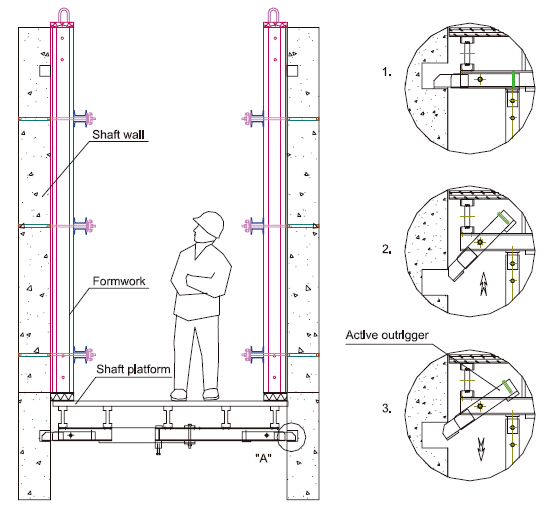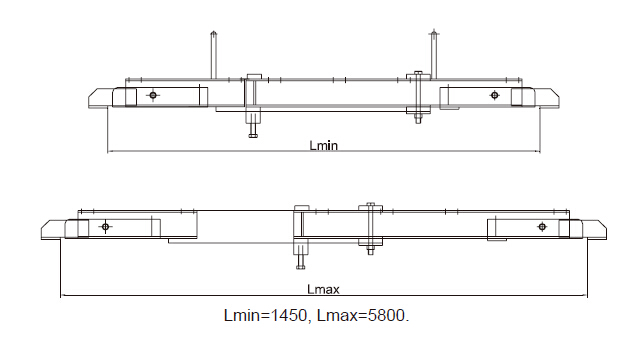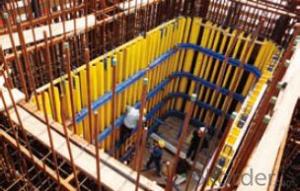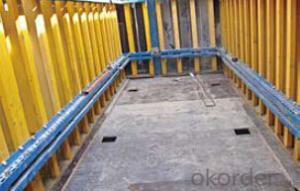Shaft-Platform System for Formwork and Scaffolding
- Loading Port:
- Tianjin
- Payment Terms:
- TT OR LC
- Min Order Qty:
- 50 m²
- Supply Capability:
- 1000 m²/month
OKorder Service Pledge
Quality Product, Order Online Tracking, Timely Delivery
OKorder Financial Service
Credit Rating, Credit Services, Credit Purchasing
You Might Also Like
Shaft Platform
As operating platform, the shaft platform is mainly used in the concrete pouring of elevator shaft,
equipment shaft, stair shaft of high-rise building and so on.
Characteristics:
◆ The length of shaft beam is adjustable.
◆ Flexible structure makes lifting easier.


- Q:How does steel formwork affect the overall durability of a construction project?
- Steel formwork can significantly enhance the overall durability of a construction project. Its robust and rigid nature helps in maintaining the structural integrity of the concrete elements being formed, resulting in stronger and more durable structures. Steel formwork is highly resistant to wear and tear, reducing the need for frequent replacements and ensuring long-term durability. Additionally, its ability to withstand high pressures and loads allows for the creation of complex and intricate structures, further enhancing the overall strength and durability of the construction project.
- Q:What are the different types of formwork corner solutions used in steel formwork?
- There are several different types of formwork corner solutions used in steel formwork, each with its own advantages and suitability for different construction projects. Some of the common types include: 1. Internal Corner Solutions: These are used to create 90-degree internal corners in the formwork. They often consist of corner brackets or angle brackets that are attached to the steel formwork panels. These brackets provide stability and support to the formwork system, ensuring that the concrete is poured accurately and without any leakage. 2. External Corner Solutions: These are used to create 90-degree external corners in the formwork. They typically consist of corner brackets or external corner connectors that are attached to the steel formwork panels. These connectors provide stability and reinforcement to the formwork system, ensuring that the concrete is poured accurately and without any leakage. 3. Adjustable Corner Solutions: These are used to create corners of varying angles in the formwork system. They often consist of adjustable corner brackets or connectors that can be adjusted to the desired angle. These solutions are particularly useful when constructing structures with irregular or non-standard angles. 4. Corner Chamfer Solutions: These are used to create chamfered corners in the formwork system. They typically consist of chamfer strips or corner chamfer connectors that are attached to the steel formwork panels. These solutions allow for the creation of beveled edges in the concrete, giving a more aesthetically pleasing finish to the structure. 5. Corner Formwork Solutions: These are specially designed formwork systems that are specifically used for creating corners in the construction project. They often consist of pre-fabricated corner panels or corner formwork molds that can be easily assembled on-site. These solutions provide a quick and efficient way to create corners in the formwork system, saving time and labor. Overall, the choice of formwork corner solution depends on the specific requirements of the construction project, including the desired corner angle, the complexity of the structure, and the desired finish. It is important to carefully evaluate the different options and select the most suitable solution to ensure a successful and efficient construction process.
- Q:What are the different types of form ties used in steel formwork?
- Steel formwork utilizes various types of form ties, each serving specific purposes and meeting distinct requirements. 1. Coil Ties: Flexibility and effortless installation and removal are provided by coil ties, which feature a coil rod with two to four coils. These ties are commonly utilized in lighter applications where lower pressure is anticipated. 2. Flat Ties: Constructed from steel, flat ties possess wide, flat plates on both ends. Their purpose is to connect opposing wall forms, ensuring stability and preventing bulging or spreading caused by concrete pressure. 3. She-Bolt Ties: She-bolt ties consist of a she-bolt attached to one end of a threaded rod. These ties secure wall forms together, and the threaded rod allows for easy formwork adjustment. 4. Snap Ties: Snap ties are a popular choice for swift and efficient formwork installation. They consist of a metal rod with a button-like head on one end and a wedge on the other. By inserting the button head into the formwork and driving the wedge into the button head using a hammer, a robust connection is created. 5. Cone Ties: Similar to snap ties, cone ties possess a cone-shaped head instead of a button head. The cone head is inserted into the formwork, and a metal wedge is driven into the cone, securing the formwork. 6. Waler Ties: Waler ties connect horizontal waler beams with vertical formwork members, enhancing the strength and stability of the formwork system. 7. Loop Ties: Made of steel wire, loop ties feature loops on both ends. They are employed to fasten wall forms together and can be effortlessly removed once the concrete has cured. 8. Pin and Wedge Ties: Pin and wedge ties comprise a pin and a wedge. The pin is inserted into the formwork, and the wedge is driven into the pin, creating a tight and secure connection. These examples represent only a fraction of the form ties available for steel formwork. The selection of a tie depends on factors such as construction type, desired strength, ease of installation, and specific project requirements.
- Q:Can steel formwork be used for precast concrete columns?
- Yes, steel formwork can be used for precast concrete columns. Steel formwork offers several advantages for precast concrete column construction. Firstly, steel formwork is durable and can withstand the pressure exerted by the concrete during the casting process. This ensures that the formwork maintains its shape and integrity, resulting in accurately shaped columns. Additionally, steel formwork provides a smooth and consistent surface finish to the concrete columns. This is important for aesthetic purposes, as well as ensuring that the columns meet the required specifications. Steel formwork also allows for easy demolding and reusability, which can significantly reduce construction time and cost. Furthermore, steel formwork can be easily customized and adapted to different column designs and dimensions. This flexibility makes it suitable for a wide range of precast concrete column applications, including various shapes and sizes. However, it is important to consider certain factors when using steel formwork for precast concrete columns. The weight of the steel formwork should be adequately supported to prevent any deformation or collapse during the casting process. Additionally, proper precautions should be taken to prevent rusting or corrosion of the steel formwork, as this can affect the quality of the concrete. Overall, steel formwork is a viable option for precast concrete column construction, offering durability, flexibility, and ease of use.
- Q:How does steel formwork affect the overall noise transmission in the building?
- The overall noise transmission in a building can be significantly affected by steel formwork. Unlike wood or plastic, steel formwork is denser and less porous, making it highly effective in reducing the transmission of sound waves through the structure. By using steel formwork, a more rigid and solid structure is created, minimizing vibrations caused by external noise sources. This rigidity prevents the amplification and propagation of sound waves throughout the building, resulting in a significant reduction in overall noise transmission and a more comfortable environment for occupants. Furthermore, steel formwork acts as a barrier to airborne sound, preventing sound waves from passing through walls or floors. This is especially important in buildings where privacy is crucial, such as hospitals, offices, or residential buildings. In addition to its soundproofing abilities, steel formwork offers other advantages. It is durable, reusable, and has a longer lifespan compared to other formwork materials. This not only reduces construction costs but also contributes to the sustainability of the building. In conclusion, the use of steel formwork in construction has a positive impact on overall noise transmission. Its density and rigidity effectively reduce the transmission of sound waves, creating a quieter and more comfortable environment for occupants.
- Q:Can steel formwork be used for airport runway construction?
- Yes, steel formwork can be used for airport runway construction. Steel formwork is a durable and versatile option that can withstand heavy loads and provide a smooth surface for concrete placement. It is commonly used in large-scale construction projects like airports due to its strength, stability, and ability to be reused multiple times, making it an ideal choice for runway construction.
- Q:What are the common maintenance practices for steel formwork?
- To ensure the steel formwork's optimal performance, various maintenance practices should be followed. These include regular cleaning and inspection, lubrication of movable parts, repair of any damage or wear, and appropriate storage when not in use. To maintain cleanliness, it is crucial to remove any concrete residue, dirt, or debris that may accumulate on the formwork. This can be achieved by using water, a mild detergent, and a stiff brush. Caution should be exercised to avoid abrasive materials or chemicals that may harm the steel. It is necessary to conduct routine inspections to identify signs of wear, damage, or corrosion. This should be done both before and after each use of the formwork. Any cracks, deformations, or loose parts should be promptly repaired or replaced to ensure the formwork remains safe and functional. Lubricating moving parts, such as hinges, locks, and adjustable components, is of utmost importance to guarantee smooth operation. Applying a suitable lubricant to these parts helps prevent rust, corrosion, and sticking. This practice helps maintain the formwork's functionality and ease of use. Repairing any damage or wear is vital to uphold the structural integrity of the formwork. Swift action should be taken to repair any cracks or deformations using appropriate methods like welding or reinforcing. Damaged parts must be replaced with new ones to uphold the formwork's strength and stability. Proper storage is essential to prolong the lifespan of steel formwork and prevent damage. It should be stored in a dry and well-ventilated area to avoid corrosion. Additionally, formwork should be stacked or stored in a manner that prevents distortion or bending of the steel components. Furthermore, protecting the formwork from moisture and excessive heat is crucial to avoid potential damage. By adhering to these common maintenance practices, the steel formwork can be preserved in excellent condition, ensuring its durability and reliability for future use.
- Q:How does steel formwork affect the overall thermal performance of the structure?
- Steel formwork can have a significant impact on the overall thermal performance of a structure. The main factor that influences this is the thermal conductivity of steel. Steel has a high thermal conductivity, meaning it can easily transfer heat from one side to the other. When steel formwork is used in the construction of a building, it acts as a thermal bridge between the interior and exterior of the structure. This can result in heat transfer across the steel formwork, leading to increased heat loss or gain depending on the external temperature. In colder climates, steel formwork can contribute to higher heat loss, resulting in increased energy consumption for heating. Similarly, in warmer climates, steel formwork can allow heat to transfer into the building, leading to increased cooling requirements. To mitigate this thermal bridging effect, various measures can be taken. One approach is to use thermal breaks, which are insulating materials placed between the steel formwork and the rest of the structure. These breaks help reduce the heat transfer through the steel, improving the overall thermal performance. Another approach is to use alternative formwork materials with lower thermal conductivity, such as insulated concrete forms (ICFs) or wood. It is important to consider the thermal performance of steel formwork during the design and construction phases to ensure energy efficiency and occupant comfort. By implementing proper insulation and thermal breaks, the negative impact of steel formwork on the overall thermal performance of the structure can be minimized.
- Q:How is steel formwork secured to the ground?
- To ensure stability and safety during the construction process, there are several methods available for securing steel formwork to the ground. Ground anchors are commonly used, typically made of steel or concrete. These anchors are driven into the ground at regular intervals along the formwork's perimeter. Steel rods or cables are then used to connect the anchors with the formwork, creating a strong and secure attachment to the ground. Alternatively, steel stakes can be employed when the ground is unsuitable for ground anchors, such as in rocky or uneven terrains. These stakes are driven into the ground at regular intervals, and the formwork is attached to them using various clamps or brackets. In addition to ground anchors and stakes, concrete footing or foundation can also be utilized to secure the steel formwork to the ground. This method involves pouring concrete footings or foundations at regular intervals along the formwork's perimeter. Bolts or other fasteners are then employed to attach the formwork to the concrete, ensuring a solid and stable connection. The specific method for securing steel formwork to the ground may vary depending on the construction project's requirements and the ground conditions. Following the manufacturer's instructions and consulting with structural engineers is crucial to ensure the proper installation and secure attachment of the formwork to the ground.
- Q:Are there any specific maintenance requirements for steel formwork systems?
- Yes, steel formwork systems require regular maintenance to ensure their longevity and efficiency. Some specific maintenance requirements can include cleaning and removing any debris after each use, inspecting for any signs of wear or damage, repairing or replacing any damaged components, lubricating the moving parts, and storing the formwork in a dry and protected environment. Regular maintenance helps to ensure that the steel formwork systems remain safe, functional, and durable for future construction projects.
1. Manufacturer Overview |
|
|---|---|
| Location | |
| Year Established | |
| Annual Output Value | |
| Main Markets | |
| Company Certifications | |
2. Manufacturer Certificates |
|
|---|---|
| a) Certification Name | |
| Range | |
| Reference | |
| Validity Period | |
3. Manufacturer Capability |
|
|---|---|
| a)Trade Capacity | |
| Nearest Port | |
| Export Percentage | |
| No.of Employees in Trade Department | |
| Language Spoken: | |
| b)Factory Information | |
| Factory Size: | |
| No. of Production Lines | |
| Contract Manufacturing | |
| Product Price Range | |
Send your message to us
Shaft-Platform System for Formwork and Scaffolding
- Loading Port:
- Tianjin
- Payment Terms:
- TT OR LC
- Min Order Qty:
- 50 m²
- Supply Capability:
- 1000 m²/month
OKorder Service Pledge
Quality Product, Order Online Tracking, Timely Delivery
OKorder Financial Service
Credit Rating, Credit Services, Credit Purchasing
Similar products
New products
Hot products
Related keywords























